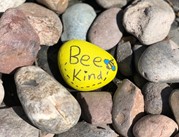By Brigitte K., AWC London and Christine Riney, AWC Hamburg, AWC London
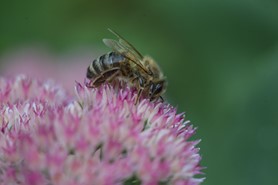 Weeds. No gardener likes a weed. They plot year after year how to make their garden weed-free. But perhaps we are thinking of weeds all wrong. What if we renamed them to “bee food,” “pollinators’ delight,” “herbal medicine,” “edibles” or “biodiversity enablers?” All those names sound so positive and are accurate.
Weeds. No gardener likes a weed. They plot year after year how to make their garden weed-free. But perhaps we are thinking of weeds all wrong. What if we renamed them to “bee food,” “pollinators’ delight,” “herbal medicine,” “edibles” or “biodiversity enablers?” All those names sound so positive and are accurate.
Here are a few garden plants that are important to pollinators, and their other uses for our health and that of our planet.
Plantain (Plantago lanceolata/Plantago major):
Plantain grows in areas that have heavy foot traffic, such as in walking paths, parks, fields where animals graze, and in your lawn.
Uses: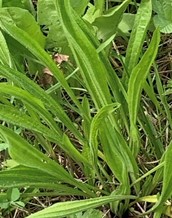
-
-
-
- It is known as a remedy for mosquito bites and stings from wasps and bees. A poultice of fresh plantain leaves is a fantastic first aid herb to ease the pain and swelling of insect bites.
- Fresh and young plantain leaves can spice up your salad and your health: it’s rich in minerals such as calcium and magnesium.
- Plantain tea can be helpful for a sore throat, dry cough and bronchitis. Use 3 tablespoons of fresh or 2 tablespoons of dried plantain leaves per cup of water. Pour the boiling water over the leaves and steep it for 15 minutes. Drink 3 cups a day.
-
-
Dandelion: (Taraxacum officinale)
Who, as a child, didn’t love to blow the white ball of fluffy parachutes of seeds and make a wish?
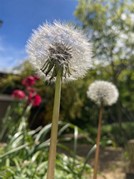
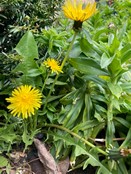
Uses:
- Dandelions start blooming from spring until early autumn and give pollinators a continuous flow of food. If you find them a nuisance in your garden, cut them back after flowering instead of spraying – but leave them growing in meadows!
- The young leaves are great in a salad and are high in potassium, so they are a great kidney tonic. Please be aware that they are slightly bitter in taste, and the older the plant the more bitter.
- Dandelion root is traditionally used as a liver tonic and was thought to help in relation to muscular rheumatism, gall bladder problems or constipation. A decoction of dandelion roots helps: again, the tea is very bitter! How to make a decoction.
Clover (Trifolium pratense):
Many of us have looked for four-leaf clovers when picnicking or crossing meadows that were full of clover.  Clover
Clover
Uses:
- According to Irish tradition, it brings luck, love, faith, and hope.
- Clover appears in areas lacking in nitrogen which is essential for plant growth, and clover helps to fix nitrogen from the air into the soil.
- It is very beneficial as a ground cover under fruit trees and along pathways in your vegetable garden and, of course, for our pollinators!
Chickweed (Stellaria media):

Given its name, it isn’t surprising that chickens and ducks love eating the greens and the seeds, which also helps to spread these pretty little blooms.
Uses:
- Chickweed benefits the soil as it enriches it with potassium and phosphorus.
- It is a good ground cover, although it spreads quickly; you can control it by pulling parts of the shallow-rooted plant out occasionally.
- Did you know that you can eat it in salad mixes or make chickweed pesto? It is a good source of Vitamin C, Vitamin A and minerals.
- It has great healing properties for cuts, wounds and irritated or itching skin and can be made into an ointment or used as a poultice.
Cleavers (Galium aparine):
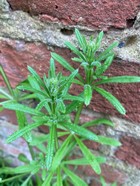
Cleavers is a creeping plant that grows in hedgerows or field margins, attaching itself to anything in its way. Children love sticking cleavers on each other’s backs hoping that it will not be noticed.
Uses:
- Cleavers are rich in Vitamin C, and in spring the young leaves can be seared and used on a sandwich or added to dishes.
- Infusions of fresh cleavers are traditionally known for cleansing the blood, especially in spring, and giving you a fresh, healthy glow. How to make an infusion.
Mullein (Verbascum thapsus):
Mullein in its first year appears with large, pale, woolly leaves that develop into an impressive 8-foot-tall flower spike in the second year. 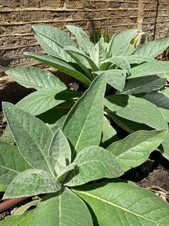 Mullein
Mullein
Uses:
- It is said to calm nerves and can help with insomnia.
- Mullein tea is great for irritating and dry coughs and sinusitis. Use fresh or dried mullein leaves and steep it for about 20 minutes.
- Compresses of leaves can be used for painful joints.
Cowslip (Primula veris):
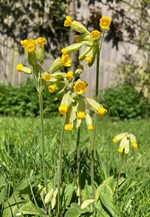
“Where the bee sucks, there suck I; In a cowslip’s bell I lie.”
William Shakespeare, The Tempest, Act 5, Scene 1
Cowslip is often called “key flower” or “key to heaven,” with reference to St. Peter, the gatekeeper of Heaven who dropped his keys when he was angry. Cowslip grew instantly where the keys dropped to Earth.
Legends associate cowslip with fairies, and the flower was used to find their precious and hidden treasures.
Uses:
-
Cowslip relaxes the nerves and goes well together with other sedative herbs to treat insomnia and stress. Try it as a tea with some lavender flowers and verbena.
-
As an expectorant, it is very useful to treat sinusitis and catarrh.
Please Note:
-
If you decide to pick your own fresh herbs, avoid roadside plants where the plants are exposed to fuel emissions and dust.
-
Make sure that the areas where you pick the plants have not been sprayed with pesticides.
-
Look out for young and tender leaves, ideally in spring. The leaves of older plants tend to be bitter.
-
Please check local regulations before picking in public spaces.
-
The freshly cut plants wither very quickly and are best eaten on the same day.
-
Always make sure you have identified the plant properly! If you are unsure, always talk to a professional.
-
The information in this article is for informational purposes only and is not meant to be medical advice.
Weeds are good for us
Weeds and other flowering plants play a vital part in a very complex ecosystem. They offer food for pollinators like bees, wasps, flies and bumblebees, and the little creatures help the flowers to fertilize each other in return. We tend to forget that most of our vegetables and fruits develop from the flowers of a plant: the cherry blossom is beautiful to look at, but in order to get cherries we need pollinators to do their job!
Whether cherries, apples, plums, blueberries, kiwis, apricots or squash, melons, cucumbers, almonds, onions, avocados (and the list goes on), they all need pollinators to help them produce the food that we eat.
The number one enemy of pollinators is pesticides/herbicides. Not only farmers are guilty of their use, but all of us who use them in our gardens or allotments or enjoy parks in cities that use these chemical sprays. Their use is contributing to the rapid decline of our natural pollinators and thus our food sources.
Weeds and flowering plants are needed to help our pollinators do their job, enrich our garden soils and help us stay healthy. Let’s support our helpers and encourage other people to be more mindful. This does not mean that we have to let our gardens grow wild. We can plant many flowering plants and shrubs which attract pollinators – and the list is long. And of course, some weeds really have to go, and there are less harmful alternatives to pesticides/herbicides. Here are 12 ways to get rid of weeds without pesticide. It is worth giving them a try this season.
When planning your garden, make sure that you provide a continuous flow of blossoms throughout the year to feed our pollinators. Even in winter, our wild pollinators can be seen flying around in search of food as soon temperatures rise above 10 °C. Winter flowering plants such as hellebores, hazel catkins, winter aconite, snowdrop, sweet box sarcococca, and winter-flowering honeysuckle can help them to get through the cold season. Check out what works for your garden and location.
If you do not have a garden, help by planting thyme, rosemary, lavender, hyssop, chives, sage or lemon balm in pots on your balcony! Besides being a food trough for our pollinators, they can be used as culinary and medicinal herbs for the people in your ife.
A few more examples to keep in mind as planting season arrives: snapdragons, sunflowers and Dahlias are easy to grow from seeds and will brighten up even most small locations. And of course, our pollinators love snacking on them.
Weeds for Nature's Needs

Weeds are good for us and our planet.
We should all rethink our plans for eliminating them, giving ourselves and pollinators a little more help to stay healthy and happy the natural way.
Resources:
Brooks-Vinton, S. (August 2018) “How to eat Dandelions” (blog) Available at: www.foodprint.org
Canale, S. (March 2017) “What is the Meaning of the Cowslip Flower - Primula Veris” (blog) Available at: www.blog.exoticflowers.com
(April 2021) “5 weeds you want in your garden” (blog) Available at: https://www.tenthacrefarm.com/weeds-you-want-in-garden/
“Cleavers” (blog) Available at: www.ediblewildfood.com
“Cowslip” (blog) Available at: www.naturalmedicinalherbs.net
Christopher, Dr. J. (1976) School of Natural Healing. Utah: Signature Book Printing
Eisenhauer et al (2019) “Recognizing the quiet extinction of invertebrates”; Nature Communications; vol. 10, Article number: 50
Farina et al (2019) “Effects of the Herbicide Glyphosate on Honey Bee Sensory and Cognitive Abilities: Individual Impairments with Implications for the Hive”. Insects, 10 (10), pp. 354
Foote, N. (July 2019) “13 of the best flowers for attracting pollinators to the garden” (blog) Available at:
https://gardenerspath.com/plants/flowers/best-flowers-for-pollinators/
https://www.bbg.org/news/weed_of_the_month_mullein
“Herb to Know: Mullein (Verbascum thapsus)” (blog)
Hoffmann, D. (1990) Holistic Herbal. London: HarperCollins
Mc Intyre, A. (2019) The Complete Herbal Tutor, London. Aeon Books
Motta, E. et al (2018) “Glyphosate perturbs the gut microbiota of honey bees”; PNAS 115 (41), pp. 10305-10310
Nafici, S. (April 2015) “Weed of the Month: Chickweed” (blog) Available at: www.bbg.org
(March 2018) “Odds Ratios and St. Patrick's Day: Are 4-Leaf Clovers Really All That Lucky?” (blog). Available at: blog.minitab.com
(March 2018) “Cleavers” (blog) Available at: www.handmadeapothecary.co.uk
(September 2015) “Plantain (Plantago spp)” (blog)
Available at: www.wildmedicinal.wordpress.com
‘Schüsselblume” (blog) Available at: www.adlerapotheke-nk.de
(July 2020) “Protection of wild pollinators in the EU — Commission initiatives have not borne fruit; Special Report 15/2020: Protection of wild pollinators in the EU” (blog). Available at: https://www.politico.eu ›
Patterson, M. (December 2016) “Winters Focus on Forage” (blog) Available at: www.apicultural.co.uk
Threben, M.(2015) Gesundheit aus der Apotheke Gottes. Steyr. Ennsthaler Verlag
Wood, M. (2008) The Earthwise Herbal, Volume 1. Berkeley. North Atlantic Books
Wood, M. (2008) The Earthwise Herbal, Volume 2. Berkeley. North Atlantic Books
Photo Credits:
https://unsplash.com/photos/F_WVShj0q7o - Bee on Clover
Photo by Mary Oloumi on Unsplash - Bee Kind
Plantago, Butterfly&Thistle - C. Riney
Dandelion, Clover, Mullein, Cowslip, Cleavers - Brigitte K.
https://pixabay.com/photos/chickweed-programming-forest-floral-1365289/

